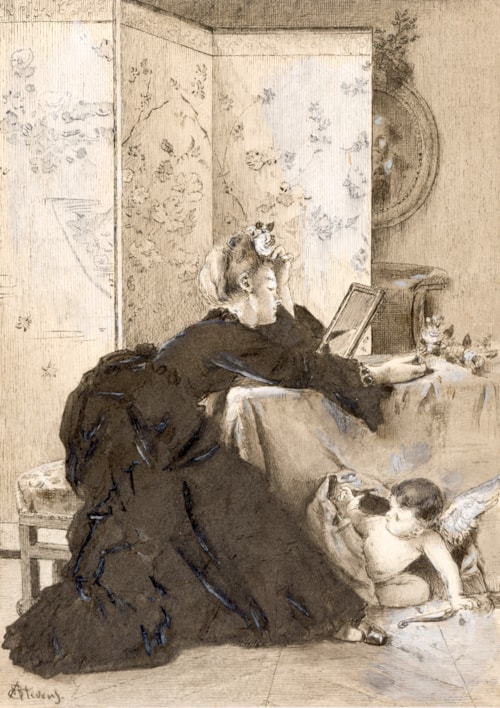
Alfred STEVENS
Brussels 1823 - Paris 1906
Biography
From the age of seventeen, Alfred Emile Leopold Stevens trained in Brussels with François-Joseph Navez, who had been a pupil of Jacques-Louis David. In 1844 he moved to Paris to study with Camille Roqueplan. (He may also have received some artistic instruction from Jean-Auguste-Dominique Ingres at the Ecole des Beaux-Arts.) Stevens returned briefly to Brussels in 1849 and exhibited at the Salon there in 1851, but by the following year he was back in Paris, where he was to live and work for the remainder of his career. He made his debut at the Paris Salon in 1853, where he won a third-class medal and had one of his paintings acquired by the State for the Musée des Beaux-Arts in Marseille. Within a few years Stevens had established his favoured genre of intimate scenes of women in modern interiors for which he was to become famous.
By the 1860s Stevens had become one of the best-known artists in Paris, part of a literary and artistic circle that included the writers Charles Baudelaire and Théophile Gautier and the painters Edouard Manet, Berthe Morisot, Jacques-Emile Blanche and Edgar Degas, to whom Stevens was particularly close. His first significant public success came at the Exposition Universelle of 1867, where he showed eighteen pictures and won a first-class medal. By this time, he had already come to the attention of several important collectors, particularly in his native Belgium. Indeed, in 1866 paintings by Stevens were acquired by both King Léopold II of Belgium and the Musée des Beaux-Arts in Brussels. The artist lived in a series of elegant studios in Paris, lavishly decorated with a fine collection of paintings, furniture and objects, and exhibited with much success in Paris, Brussels, Antwerp and elsewhere.
Stevens developed a particular speciality of paintings of the elegant women of Paris, dressed in their finery or getting ready for balls or visits. He was a master at depicting rich silks, crinolines, ribbons and jewellery, and in his studio kept several lavish dresses to be used by his sitters. (He also occasionally borrowed dresses from such friends and clients as the Austrian socialite Princess Pauline von Metternich.) The artist achieved a considerable reputation for these stylish works, and his great success allowed him to establish a luxurious lifestyle, and to build a collection of Japanese and oriental objects. It was in the 1870s that his paintings first came to the attention of American collectors such as the Vanderbilts in New York and William Walters in Baltimore, and a large number of significant pictures by the artist are today to be found in American museums. In the 1880s Stevens began teaching young artists in his studio, many of whom were women. At the end of the decade he worked, in collaboration with a former pupil, Henri Gervex, on a monumental painting entitled Panorama of the History of the Century, which was displayed in a special pavilion at the Exposition Universelle of 1889. Stevens continued to paint until 1899, when a bad fall left him confined to a wheelchair. The following year he was accorded a large retrospective exhibition of more than two hundred works at the Ecole des Beaux-Arts in Paris; an unprecedented honour for a living artist.
Stevens’s paintings were much admired by many of his contemporaries, including Degas, Manet, Paul-César Helleu, Claude Monet and Auguste Renoir. At his death in 1906, one obituary praised the artist’s ability to ‘make a fresh and living art out of material which no painter had seriously employed for half a century – the fashionable woman of Paris – and so to become an influence upon the photographic art of Tissot, the milliner’s work of Carolus-Duran, and to a lesser degree, perhaps, upon men of the rank of Manet and Whistler…Stevens’s best work anticipates not a few of the qualities of design and spacing that made Whistler’s fame, coupled with a true painter’s sense of pigment, and a touch so light, so orderly, so expressive and so tender that his pictures were as much admired by artists as his subjects were by the fashionable public.’ A comprehensive memorial exhibition of Stevens’s work was held in Brussels and Antwerp in 1907.



